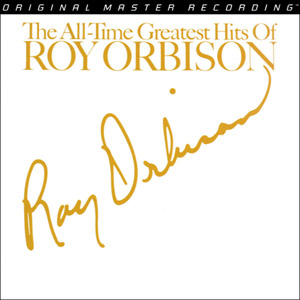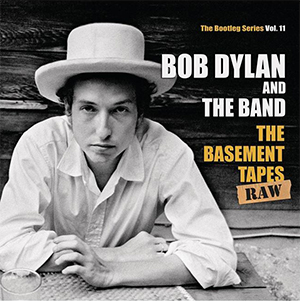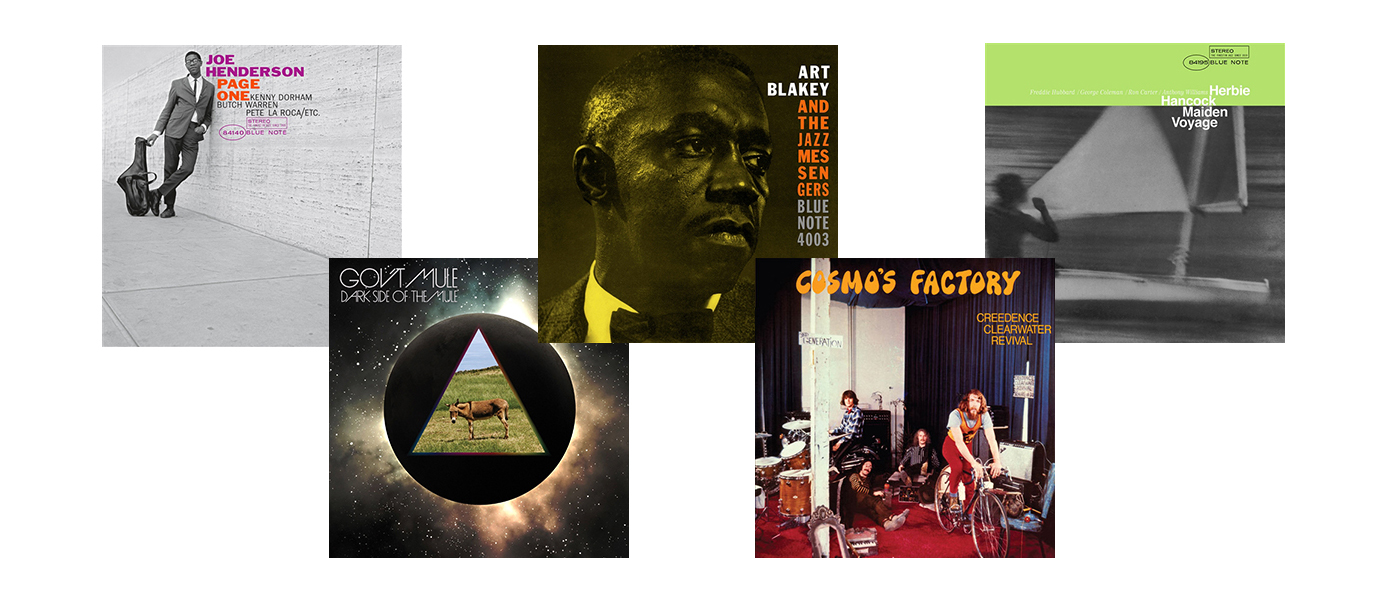Roy Orbison “The All-Time Greatest Hits of Roy Orbison” Mobile Fidelity Sound Lab
- Performance:

- Sound:


I was first exposed to Roy Orbison as a member of the Traveling Wilburys. He was a member of the Wilburys I mean, not me. I was already a fan of the other members, even Jeff Lynne because I liked that “Don’t Bring Me Down” song, but I didn’t know what to make of Orbison. He looked strange and sounded stranger. I was in eighth grade, you understand, and soon to break out of my dependence on Top 40 radio as a means of discovering important music. But not yet. Not quite. By 1998, I wanted to be Slash instead of Michael Jackson. Who’d have guessed back then that I’d bet on the right guy in that duo? Dylan was an exotic diversion as I’d already burned through Harrison’s work with the Beatles and Petty’s with the Heartbreakers. Orbison just seemed like he’d fallen out of the sky and landed amidst all of these more established, younger but still old, Rock and Rollers. I didn’t know anything about anything, did I? Maybe I’ll find out one day that I still don’t. I hope so. But I do know one thing for certain, and this is it: Roy Orbison was a badass. His All-Time Greatest Hits will prove it if you don’t believe me. Just make sure you’re listening with the right ears.
Those ears are going to have to make some accommodations if this record is going to be experienced in the proper way. First, they’re going to have to hear past some seriously dated backing vocals. Cringe worthy in some respects, I’d say. I feel the same way about some of Patsy Cline’s work. Things were pretty vanilla in those days, I reckon, but the vocal backing style of the day was positively syrupy. By now, it’s hard to hear Orbison without the event being colored by the knowledge of his standing in Rock and Roll history. He might not look like a Rocker, but ask Bruce Springsteen how he feels about that. Or Tom Waits or Elvis Costello. All of whom played quite gleefully in Orbison’s backing band for his Black and White Night special from 1988. None more gleefully than Springsteen though. He’s so unselfconsciously giddy that you can’t help but smile right along with him. And he’s doing a ton of smiling in that film. Find it if you haven’t seen it. And I’ve never read up on Phil Spector’s influences, but I’d find it hard to believe that he wasn’t into Orbison’s grander, more orchestral work. If that’s true, Orbison’s influence on popular music is even more pronounced than I’m giving him credit for. Regardless, these songs are woven into the very fabric of American popular music. “Only The Lonely,” “Crying,” “Oh, Pretty Woman,” and “Blue Bayou” are all represented here in their original glory. It should be noted that this is a Mobile Fidelity Sound Lab release so every bell, every chime, every guitar chord and all of those aforementioned vocals have been pulled from the original master tapes. The depth of field and the sonic clarity is almost disorienting. You could take shelter beneath the sturdy gatefold cover while reading Boudleaux Bryant’s essay from under there if you were so inclined. The two heavy discs are flawlessly quiet and they carry all of the considerable information within these grooves effortlessly and without introducing any artifacts of their own. I don’t know how MoFi is able to do it so consistently while others are pressing noisy, scratchy records with alarming regularity, but you can’t know the good until you’ve heard the bad I guess. This is the good. I can’t imagine that it’s ever going to get better.
TV On The Radio “Seeds” Harvest Records
- Performance:

- Sound:


I’ve been all over TV On The Radio since their Dear Science record from 2008. It’s still one of my favorites of the last decade. Their last one didn’t make as much of an impression on me, but I like it more than most and I caught their live show in support of it. I was appropriately blown away. This brings us to Seeds. It’s been available for a few months now, but I had to wait for a repress so I guess it’s selling just fine without my help. As well it should. These guys have been through a lot over the last few years, and I’m really glad that they got back on the horse. This world needs about a thousand TVs On The Radio, but there is, to be certain, only one. If you’ve not been indoctrinated, Seeds would be a fine point of entry.
This is their first release since the death of their bassist which occurred almost immediately upon release of Nine Types of Light. He was 36 and he died of lung cancer. I can’t tell how, exactly, his absence has informed the band’s sound, but Seeds seems even busier to me than the band’s previous works. Dear Science had layers for days, but “Happy Idiot,” for instance, is downright frantic. Album opener, “Quartz,” is more playful and jumpy, but fussy none the less. At no point do I ever feel claustrophobic listening to Seeds, but the sound is not particularly three dimensional either. Nor does the production lend itself to transparency. I mean, you never really feel like the band is in the room with you. It’d have to be a pretty big room to hold all this sound in it anyway. Even the comparatively docile “Test Pilot” sounds a little thin with all of the electric textures and sustained guitar chords. The vocal performances are as compelling as ever with Tunde Adebimpe, especially, finding a million peaks and valleys to explore. I’d be curious to hear these songs performed in a more stripped down environment. Not the most original idea, I realize, but I’d like to hear what an organ could do in place of a synthesizer. Some piano notes instead of computer beeps. As I understand it, we mostly have producer (and band member) David Sitek to thank for all of this jocund din. And I appreciate what he does. This is a truly original sound. I never wonder if I’m hearing TVOTR when I’m hearing TVOTR. I know it immediately like I know when the wind is in my face. Still, I’d like to peal some of the layers off of this beautiful onion. Just once. For a minute. Conversely, I often have an allergic reaction to string sections in pop music, but I always love it when these guys get a hold of one. Overall, Dear Science is still the band’s strongest work that I’m familiar with, but that’s clearly a matter of personal preference. I’m sure the band’s early adopters in Brooklyn feel like they’d sold out by that point. And these songs seem even more radio friendly. If the radio were a friendlier place, I mean.
Even the artwork on Seeds is disorienting and bewildering. The album comes with a treated piece of plastic that you slide around on the cover to make the artwork move and jump. The records themselves are on tie-died pastel wax. The pressings are not flawless, but they’re passable. The album includes a download coupon and the work might actually lend itself to the digital format. I’m glad to have the vinyl version though. It’s a keeper.
Neil Young “Zuma” Reprise Records
- Performance:

- Sound:


Speaking of the ditch, we’ve been looking at the contents of yet another box from late last year that has fallen far short of my hopes and expectations. Neil Young’s Official Release Series Discs 5 – 8 includes his “Ditch Trilogy” along with Zuma which came following after. Of all of the records in the box, I was least excited about Zuma. It turned out to be sonically superior to the others, but I’m really hoping that my box was an anomaly and that others aren’t enduring the same struggles that I have endured at the merciless hands of this shoddy product. A shoddy vinyl package from Neil Young feels like buying a lemon of a Lamborghini. I waited many months for this release, and I’d have waited many more if they’d taken the time to get it right. I’m no conspiracy nut. I’m not going to suggest that Neil turned his back on vinyl to be the face of the Pono digital music player. I wholeheartedly suggest that Young’s archive releases have been consistently dazzling up until now. Which is too bad because I think this set contains some of Neil’s best work. Hands down, it does, in fact, and now I’m just getting mad all over again.
Pallas is considered by many to be the preeminent pressing plant in the vinyl industry. I’ve certainly thought of them in those terms for many years now. Mostly on the strength of their work on Neil’s archival series. While Zuma has more presence and is significantly more dynamic than the other titles in this set, it’s still noisy in spots. I can’t imagine what happened. Did they get in a hurry? Was there a strike? Were these discs pressed by unworldly scabs? Without the ticks and tocks, the guitars sound transparent. Neil’s vocals sound warm and alive unlike on the legendarily muddy Time Fades Away. To be certain, much of this is due to an increased quality in the recording techniques used during the making of Zuma after the ragged but so, so right Tonight’s The Night. But that’s kinda the point. These all analog productions have proven to be superior in many ways to Young’s originals. The grooves clearly carry more information than they did in the ’60’s. Sure, there’s a trade-off when you consider the age of the tapes being used, but it beats rolling off the bass to accommodate inferior stereo equipment. Relieved of concern for our turntables’ abilities, we should all be free to luxuriate in the newfound glory that these grooves contain. Tonight’s the Night should still sound dark, but also sound livelier. As it is, I spend all my time obsessing over the noise involved, and stewing about the record company’s lack of a response to my $160 questions.
Still, Zuma has plenty to recommend it. Like “Barstool Blues” and “Cortez the Killer.” I love Neil’s textured album sleeves from this era too, and Zuma is especially tactile. These reissues are great for that as they come with all the extras, all the candy. Sadly, a couple of my discs also came with split seams. One came with a mess of distortion, and all came with way more surface noise than I’d ever heard out of Pallas records before. Neil has a reputation for being a conscientious artist. One who values and sticks up for his fan base. But he’s aligned himself with a label that doesn’t share that concern. I got hosed on some Third Man records recently too, but they responded to my questions. They made an effort. At this point, my effort is all tied up in trying to pretend that this box set never happened.
Wilco “Alpha Mike Foxtrot: Rare Tracks 1994-2014” Nonesuch
- Performance:

- Sound:


I remember comparing Wilco’s debut record to Son Volt’s and thinking that Wilco didn’t stand a chance. I liked A.M., but I liked Son Volt’s Trace way better. Still do. That never happened again. I had no way of knowing how wildly Jeff Tweedy’s art would careen from lane to lane, sometimes jumping off the pavement altogether and heading full bore towards the ditch. Almost always revealing another layer of surprise and craftsmanship that changed the band’s euphonic trajectory just in time to flip over on itself and to spin out in another unpredictable direction. For 20 years. I’ve been trying to keep up with them for 20 years? That’s twice as long as the Beatles were together, and half as long as I’ve been alive. That’s crazy. In celebration of “making it” for two decades, Wilco put out a straight-up retrospective on CD which included album tracks from throughout their history, and Alpha Mike Foxtrot: Rare Tracks 1994-2014. That one’s on vinyl, and that’s where the magic’s at, gang. Trust me on this one.
As I mentioned in the Basement Tapes review, AMF went fast. I almost missed it, and a quick internet search shows that you gotta pay substantially more for a new copy now than you would have if you’d ordered it from the band’s web store which is completely sold out. To the surprise of no one, I would recommend that you do it anyway. Maybe there will be a repressing, but I wouldn’t dawdle. Especially if you don’t have copies of the songs in other formats elsewhere. I had a lot of the material in my digital collection. The band released their Ashes of American Flags DVD as part of Record Store Day a few years back, and some of this material was made available as a bonus digital download at that time. But not nearly all of it. And we’re not here to talk about downloads. Most, if not all, of the songs in the box are presented in chronological order, and the quality of the recordings improves as time goes on. Some of the earliest material was recorded by Jeff Tweedy solo on his wife’s Dictaphone recorder which was alleged to have been the size of a dictionary. That fits this set perfectly as it seems to be a sort of reference recording on its own. The earliest recordings sound like what you would expect from a person sitting in a living room performing off mic into a rudimentary device. The songs and performances are pretty rudimentary too, by comparison. Looking back through this document, I have no embarrassment at all about the fact that I didn’t recognize Wilco’s and Tweedy’s genius right away. I don’t feel like it had revealed itself yet. It jumped right up and announced itself on Being There and it’s been on full display ever since. (Alright, it might have taken a couple of brief vacations over the years, but not many and not for long.) There’s precious little material from the hallowed Yankee Hotel Foxtrot era, but the other records are pretty well represented. It’s a fascinating trip through an astonishing musical history, and the sounds and songs only improve with time. This band’s legacy will be viewed as an expansive body of work. They can do so much more than the Foxtrot. We’re all witnesses.
The set includes a digital download, but, more importantly, it includes a well-rendered, full-sized book in living color with rare photos and insightful essays by band members. And a track-by-track song history by Tweedy himself. The pressings are great too. This one’s essential.
Bob Dylan and the Band “The Basement Tapes Raw” Columbia Records
- Performance:

- Sound:


Last year’s Holiday Season saw an intimidating flurry of vinyl box set releases. I’m running a little short on space in this San Francisco sardine can apartment and I couldn’t really afford to get everything I wanted. But, obviously, I couldn’t afford to not get everything I wanted either and so I redoubled my efforts, moved some stuff around, and have been boxing my own ears ever since. We’ve already looked at the disastrous Jack White Bonnaroo set, but the true disaster would have been if I’d let Dylan’s and Wilco’s sets slip by. The latter appears to be in short supply, but Dylan’s ain’t going nowhere. You could probably wait for the price to drop on that one if you’re so inclined. Not me.
I had a skewed idea of what to expect from The Basement Tapes Raw. The attendant press release described multiple available versions, and I may have let my excitement distort my understanding of what I had coming my way. Most of the songs on the three-record set are on the “original” official Basement Tapes release. By now, we all know that the songs on that version were doctored up with overdubs and reverb before going to market. (We should also know that MoFi did a version a while back that is pretty transcendent.) The songs on the newer set are, as the title implies, less processed. This is as good a time as any to go ahead and say that this set has very little in the way of audiophile quality material. By that, I mean that it has no audiophile quality material at all. These sessions were recorded on a reel-to-reel in a house in the late ’60’s. There’s warbling and hissing. Some, perhaps many, songs cut out suddenly and without warning never to be heard from again. It feels a lot like the modern literary trend of simply ending a novel or short story without resolution of any kind. Initially, I was a little disappointed about the amount of content included on the vinyl version which is essentially a “best of” the more comprehensive 5 CD set. I’m usually of the opinion that the vinyl version of any release should be the definitive version of that release. If there is going to be bonus content, it should be on wax, basically. But I was wrong this time. Here’s what should have happened: the records should have been presented as is, but the CD version that comes with the vinyl box should have included all 5 CDs worth of material rather than just the two CDs that are part of this set. Everybody wins in that arrangement. I’m no Dylan completist so I don’t feel like I got robbed or anything, but we all know that a CD costs less than a nickel so why not give us the farm for once?
Beyond that little quibble, this set is a blast for fans of Dylan and the Band. Here, the songs are presented as either “restored” (without the additional reverb or mixing found on the 1975 Basement Tapes), “without overdubs,” or as an “alternate version” (different performance of a song from the ’75 release), or “unreleased” (of which there are plenty). If you don’t know the legend behind The Basement Tapes, you’ll want to before you dig in. It will help you manage your sonic expectations. If you’re already in the know, you’ll realize that you can’t rightly move through this world without having the Raw version in your collection. The full-sized book is worth the investment on its own.


